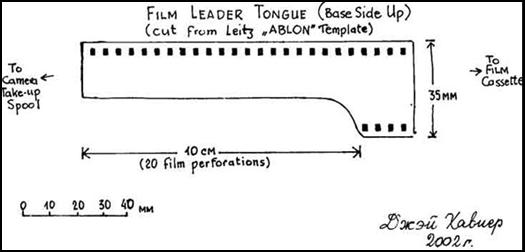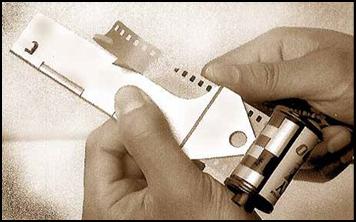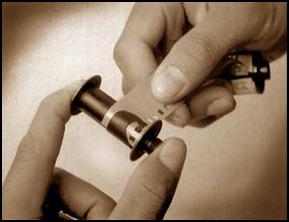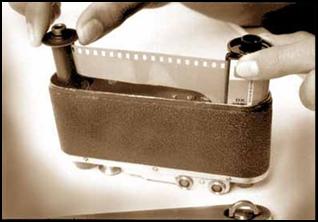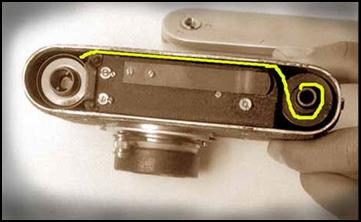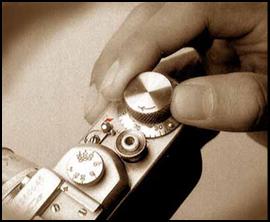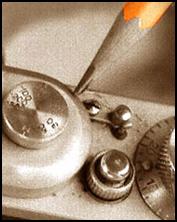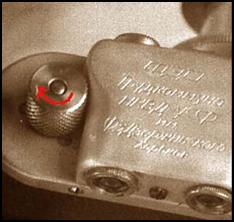
|
Film Loading and Film Leader Trimming |
|
FED and Zorki, like the Leica, are bottom loaders. As such, they will only load properly with film which has the long, old-style film leaders. 35mm film used to be available with such long leaders. New ones have shorter tongues, which must be cut longer for proper loading.There have been suggestions which call for all sorts of tricks to coax short-leader films into threading into these cameras. Removing the lens, opening the shutter and inserting cards and fingers into the camera isn’t healthy for the camera. The pressure plate can tarnish and the springs supporting it can be damaged. THERE IS ONLY ONE CORRECT WAY TO LOAD THESE CAMERAS, and that is, by loading them as originally instructed.
|
|
Factory loaded film with contemporary film leader cut |
|
The required film leader cut for bottom loading cameras is 10 –11 cm long and about 2,5 cm wide. It should taper gently towards the shoulder and no rough corners around the cuts. |
|
Modern film leaders can be cut to proper shape using a template such as the Leitz „ABLON”. With some practice, the leader can also be cut free-hand using a pair of SCISSORS alone, following the shape given above. |
|
STEP 1: Insert the tip of the leader into the spool’s spring clip. Early spools and Leitz spools did not have the hook type clip. Draw out enough film so that the span between the film magazine and spool is about 12 cm. Have about two perforations’ length of film at the sloped side out of the magazine’s lips before inserting it with the spool in the camera. |
|
STEP 2: Insert both the magazine and take-up spool at the SAME TIME. If the film magazine does not go in easily, try turning the rewind knob so that its fork engages with the magazine spool. When both are inserted, check if the film sprocket holes engage with the camera’s sprocket teeth. Wind the advance knob to see if the engagement is correct. REPLACE AND LOCK THE BOTTOM COVER. |
|
Film runs through the camera in this path, as represented by the yellow line. Damaged winding gears or springs can cause the film to loosed and clog up the take-up side of the camera. |
|
STEP 3: Turn advance knob and fire twice. Set frame counter (using the nipples on the disk) to „0”. Turn only in a CLOCKWISE direction to avoid damaging the winding brake spring. When the end of the roll is reached, the knob will no longer turn easily. |
|
WHEN THE ROLL IS DONE: To start rewinding, shift the lever first to “B” position to disengage the winding gears (left picture). Then, pull up the rewind knob and turn towards the direction of the arrow engraved on it until all the exposed film is reeled back into the film magazine. The shutter release button collar will turn as the film is being pulled through. Some resistance will be felt when the leader end of the film is reached. Continue winding until all the film is pulled back in the magazine. |
|
A VERY STUPID WAY TO LOAD FILM |
|
There is only one correct way to load film into a FED, Zorki (1,S,2,2s,and 5) LTM Leica, some Canon RF, Zenit-1,S, 3, and other bottom loading cameras: as it had been instructed! Barnack and his colleagues at Leitz have long ago determined it to be so. Any other method would prove to be clumsy, tricky, fail-prone, slow, and awkward. These could also lead to damage to both camera and damage; using a loading method such as the one show in the picture would also open the camera literally to contaminants.
Some users think that they have devised a better method than Barnack. They actually think that they could do shortcuts and use a “better” loading method. These people suggest inserting a card into the film channel to coax the film into the camera. This odd method even requires to have the shutter locked open at B so that the film could be „fingered“ into position. This method is even supposed to do away with the cutting to shape a long-tongued film leader, and enable the modern short leader to be threaded as is into the camera.
Their claim that this awkward method to be simpler, easier, or faster is really a contradiction. The method is really clumsier. It requires that the camera be held flat for the duration of the loading. It requires that a card be inserted slowly and carefully into the film channel. It needs the lens to be off, exposing the camera to contamination. It requires the shutter to be held open. It requires the user to poke the camera through its lens mount with his finger. It requires plenty of finger calisthenics to coax the film into position. It requires the camera’s pressure plate to bear the thickness of both film and card in the very tight film channel and bear on the delicate springs which hold the plate against the camera’s fixed, inflexible back. For a method which is supposed to be easier and faster, this certainly has too many requirements.
How these people could claim this method to be simpler is a mystery. All the above steps in place of cutting the film leader properly. Strange, isn’t it? How could cutting film be more difficult? Cutting it to the required shape is the most critical aspect, and this isn’t really too difficult to do.
Properly loading a bottom-loading camera is a skill which isn’t quickly acquired. It might even seem impossible for people who have known nothing but auto-loading cameras which run on micromotors. But it isn’t difficult either. Practicing with a dead roll can give one the skill needed to load the FED properly. It is a skill learned through trying and using. After mastering the skill (it only takes a few rolls to do this), one could load a bottom-loader in less than a minute. In fact, it’s possible to load a camera in less than 30 secs. I’ve seen people do it. I’ve done it.
|


